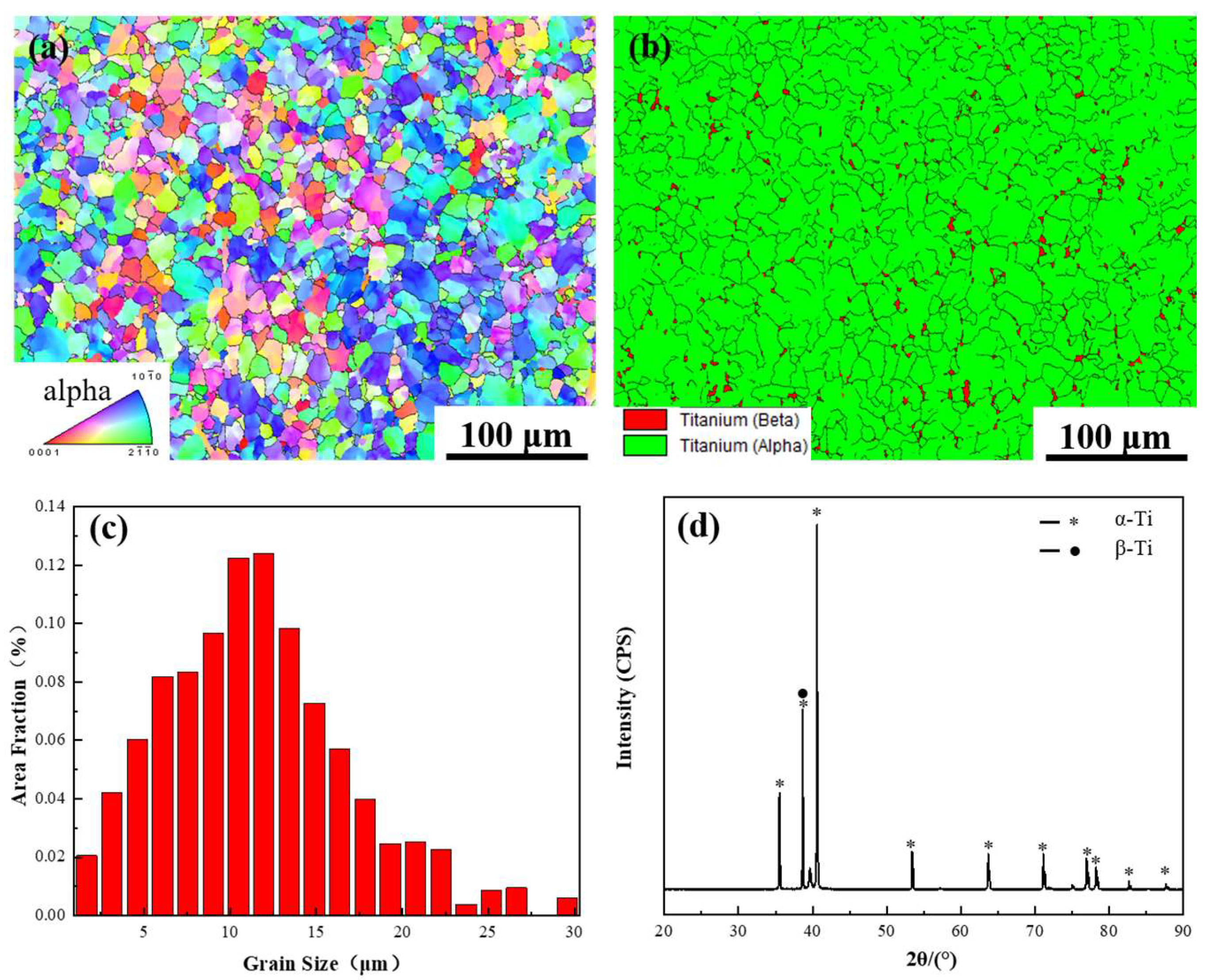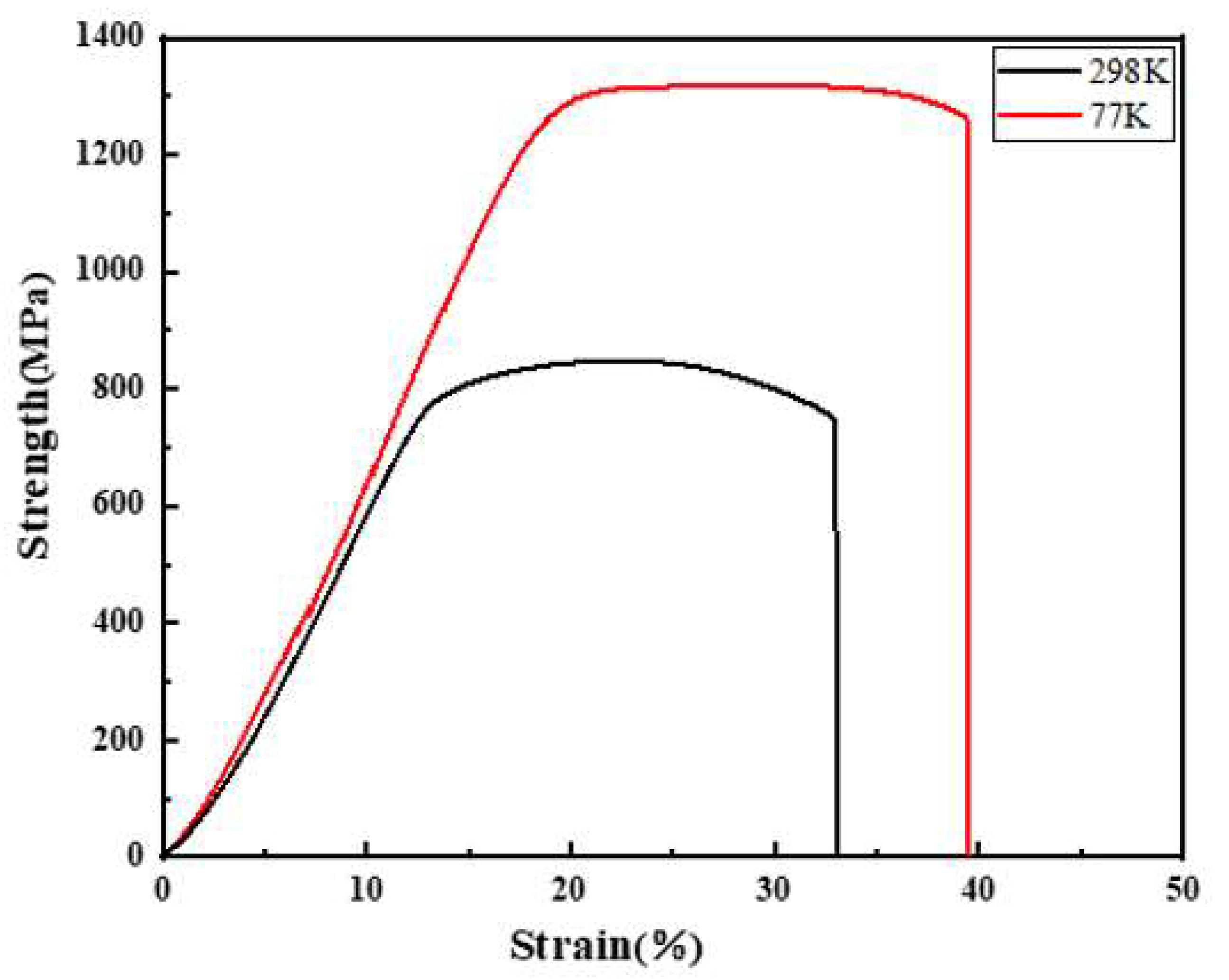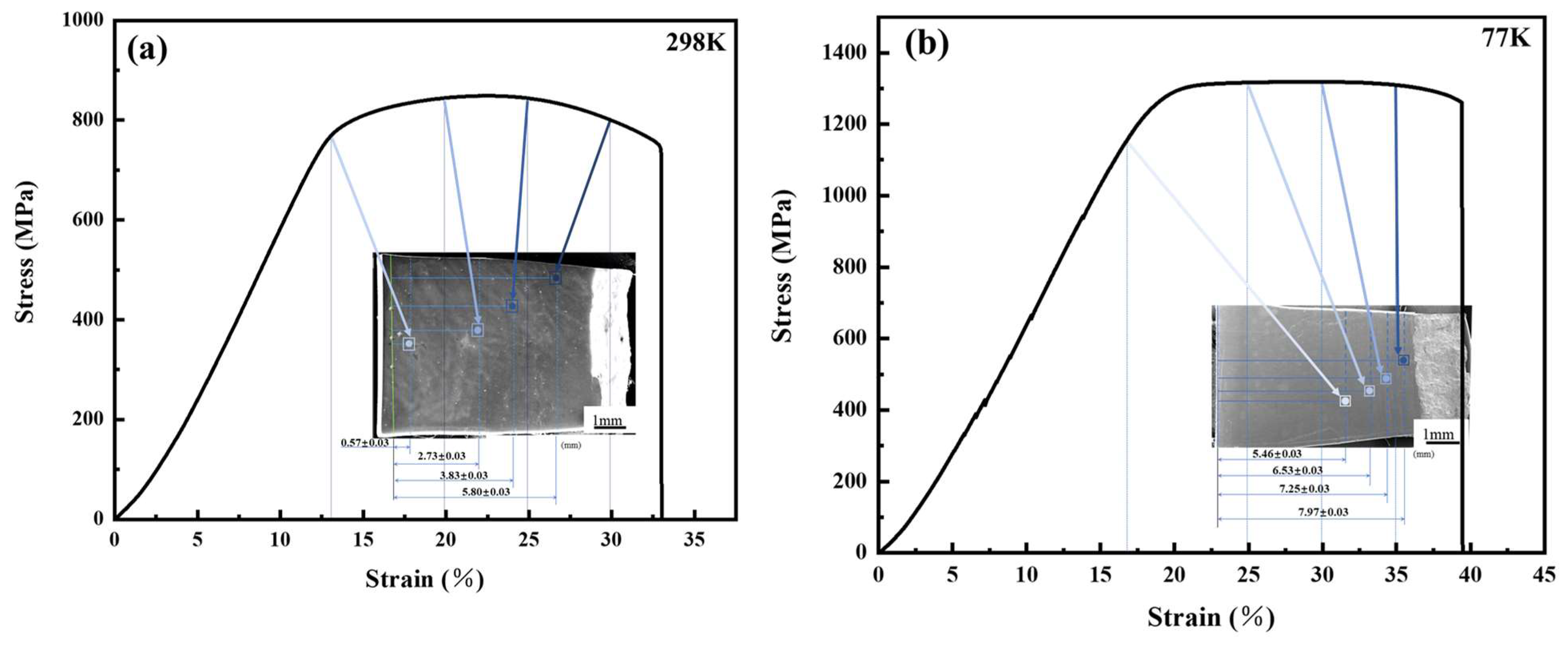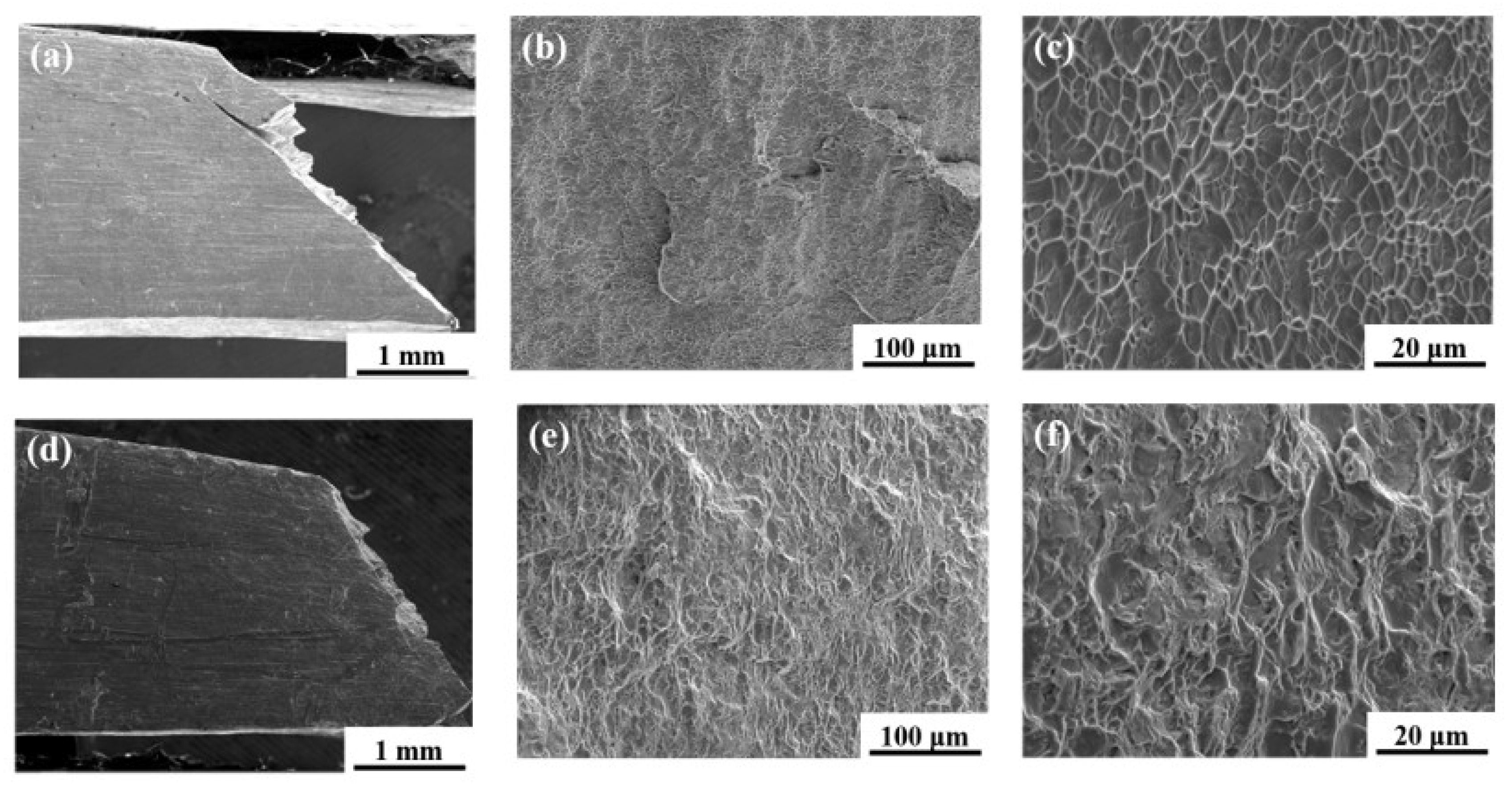Microstructure and Mechanical Properties of TC4 Titanium Alloy at the Temperature of 77K
Abstract
:1. Introduction
2. Materials and Methods
3. Results and Discussion
3.1. Microstructure of TC4 Titanium Alloy
3.2. Analysis of Mechanical Properties of TC4 Titanium Alloy
3.3. Quantitative Calculation of TC4 Titanium Alloy Non-Deformation
3.4. Microstructure Evolution of Mechanical Properties of TC4 Titanium Alloy
3.5. TC4 Titanium Alloy Fracture Morphology Analysis
4. Conclusions
- After low-temperature treatment, the tensile strength of TC4 alloy at room temperature is 847.9 MPa and the engineering strain is 33.1% at the strain rate of 5 × 10−4 s−1. The tensile strength is 1318.7 MPa and the engineering strain is 39.5% at low temperature. The strength and toughness are in an increasing state at low temperature.
- The grains of TC4 titanium alloy are broken and refined during the tensile process. With the increase in strain, the local strain will first concentrate in the secondary α grains and then crack, and the stress concentration position will shift to complete fracture. Under the same yield stage, the stress concentration area of titanium alloy in low-temperature deformation environment is more, and twinning behavior is more likely to occur.
- The micro-fractures of TC4 titanium alloy at room temperature and low temperature show ductile fracture. The size of dimples is equiaxed. The number of dimples at low temperature is more than that at room temperature. The depth of dimples at low temperature is shallower and the overall performance is more even.
Author Contributions
Funding
Institutional Review Board Statement
Informed Consent Statement
Data Availability Statement
Acknowledgments
Conflicts of Interest
References
- Wu, C.; Zhou, Y.J.; Liu, B. Experimental and simulated investigation of the deformation behavior and microstructural evolution of Ti6554 titanium alloy during an electropulsing-assisted microtension process. Mater. Sci. Eng. A 2022, 838, 142745. [Google Scholar] [CrossRef]
- Wang, D.; Dong, H.; Ma, Y.; Li, P.; Wu, B.; Huang, L.; Zhang, L.; Li, J. Microstructure and mechanical properties of TC4 titanium alloy and 316L stainless steel joint by MIG welding with mortise structure. Weld. Int. 2022, 36, 732–743. [Google Scholar] [CrossRef]
- Zhang, Y.; Li, M.; Jiang, K.; Wang, H.; Qu, P.; Wang, H.; Zhu, L. Constitutive Behavior of Titanium Alloy with Dual-Phase Microstructures: Experiments and Modeling. J. Appl. Mech. 2023, 90, 071009. [Google Scholar] [CrossRef]
- Miao, K.; Huang, M.; Xia, Y.; Wu, H.; Liu, Q.; Fan, G. Unexpected de-twinning of strongly-textured Ti mediated by local stress. J. Mater. Sci. Technol. 2022, 125, 231–237. [Google Scholar] [CrossRef]
- Qiu, Y.; Yang, H.; Tong, L.; Wang, L. Research Progress of Cryogenic Materials for Storage and Transportation of Liquid Hydrogen. Metals 2021, 11, 1101. [Google Scholar] [CrossRef]
- Jin, L.; Yang, Y.-F.; Li, R.-Z.; Cui, Y.-W.; Jamil, M.; Li, L. Study on Springback Straightening after Bending of the U-Section of TC4 Material under High-Temperature Conditions. Materials 2020, 13, 1895. [Google Scholar] [CrossRef]
- Mukhopadhyay, M.; Kundu, P.K.; Das, S. Experimental investigation on enhancing grindability using alkaline-based fluid for grinding Ti-6Al-4V. Mater. Manuf. Process. 2018, 33, 1775–1781. [Google Scholar] [CrossRef]
- Chen, W.; Liu, X.; Bu, H.; Wang, F.; Luo, J. Effect of scanning mode on temperature field and interface morphology of laser joining between CFRTP and TC4 titanium alloy. Int. J. Adv. Manuf. Technol. 2022, 123, 2057–2072. [Google Scholar] [CrossRef]
- Omura, H. Application and Manufacturing Technologies of Titanium Alloys for Aircraft Industry(2). Titan. Jpn. 2012, 60, 289–294. [Google Scholar]
- Lei, L.; Zhu, Q.; Zhao, Q.; Yang, M.; Yang, W.; Zeng, W.; Zhao, Y. Low-temperature impact toughness and deformation mechanism of CT20 titanium alloy. Mater. Charact. 2023, 195, 112504. [Google Scholar] [CrossRef]
- Rui, Z.L.; Feng, C.; Long, J.; Cao, Y.Q. Research Status and Development of Titanium Alloy Drill Pipes. Mater. Sci. Forum 2019, 944, 903–909. [Google Scholar]
- Zherebtsov, S.V.; Dyakonov, G.S.; Salem, A.A.; Sokolenko, V.I.; Salishchev, G.A.; Semiatin, S.L. Formation of nanostructures in commercial-purity titanium via cryorolling. Acta Mater. 2013, 61, 1167–1178. [Google Scholar] [CrossRef]
- Liu, T.K.; Wu, G.L.; Liu, C.K.; Nie, Z.H.; Ungar, T.; Ren, Y.; Wang, Y.D. Interface coherency strain relaxation due to plastic deformation in single crystal Ni-base superalloys. Mater. Sci. Eng. A 2013, 568, 83–87. [Google Scholar] [CrossRef]
- Choi, J.H.; Lee, S.J.; Choi, D.H. Tolerance Optimization for Mechanisms with Lubricated Joints. Multibody Syst. Dyn. 1998, 2, 145–168. [Google Scholar] [CrossRef]
- Zhao, Y.; Yang, G. Some Titanium Alloys Developed by NIN and Their Industrial Manufacture. Titan. Ind. Prog. 2006, 6, 65–70. [Google Scholar]
- Zhao, Y.-q.; Zhou, L. Current research situation of titanium alloys in China. Mater. Res. Appl. 2005, 15, 82–91. [Google Scholar]
- Huang, C.; Ge, P.; Zhao, Y.; Xin, S.; Zeng, W. Research Progress in Titanium Alloys at Cryogenic Temperatures. Rare Met. Mater. Eng. 2016, 45, 254–260. [Google Scholar]
- Azmirruddin Ahmad, M.; Jabir, M.; Johari, N.; Ibrahim, R.; Hamidi, N. The effect of impurities elements on titanium alloy (Ti-6Al-4V) MIM sintered part properties. AIP Conf. Proc. 2017, 1901, 40007. [Google Scholar]
- Yang, W.; Ji, W.; Zhou, Z.; Xu, J. Analysis of Deformation Behavior and Microstructure Changes for α/β Titanium Alloy at Elevated Temperature. Met. Open Access Metall. J. 2021, 11, 303. [Google Scholar] [CrossRef]
- Ouchi, C.; Iizumi, H.; Mitao, S. Effects of ultra-high purification and addition of interstitial elements on properties of pure titanium and titanium alloy. Mater. Sci. Eng. A 1998, 243, 186–195. [Google Scholar] [CrossRef]
- Zhang, W.; Chai, D.; Ran, G.; Zhou, J. Study on microstructure and tensile properties of in situ fiber reinforced aluminum matrix composites. Mater. Sci. Eng. A Struct. Mater. Prop. Misrostruct. Process. 2008, 476, 157–161. [Google Scholar] [CrossRef]
- Prakash, D.L.; Ding, R.; Moat, R.; Jones, I.; Withers, P.; da Fonseca, J.Q.; Preuss, M. Deformation twinning in Ti-6Al-4 V during low strain rate deformation to moderate strains at room temperature. Mater. Sci. Eng. A 2010, 527, 5734–5744. [Google Scholar] [CrossRef]
- Castany, P.; Pettinari-Sturmel, F.; Crestou, J.; Douin, J.; Coujou, A. Experimental study of dislocation mobility in a Ti–6Al–4V alloy. Acta Mater. 2007, 55, 6284–6291. [Google Scholar] [CrossRef]
- Castany, P.; Pettinari-Sturmel, F.; Douin, J.; Coujou, A. In situ transmission electron microscopy deformation of the titanium alloy Ti-6Al-4V: Interface behaviour. Mater. Sci. Eng. A Struct. Mater. Prop. Microstruct. Process. 2008, 483–484, 719–722. [Google Scholar] [CrossRef]
- Sun, Y. Corrosion Behavior of Ta-10W Coatings on CP-Ti and TC4 Substrates. J. Mater. Eng. Perform. 2019, 28, 4152–4162. [Google Scholar] [CrossRef]
- Zheng, L. The variation of microstructures, textures and mechanical properties from edge to center in cross section of Ti6242s titanium alloy. Vac. Technol. Appl. Ion Phys. Int. J. Abstr. Serv. Vac. Sci. Technol. 2019, 160, 81–88. [Google Scholar] [CrossRef]
- Garza-Ramos, M.; Estupian-Lopez, F.H.; Gaona-Tiburcio, C.; Beltrán-Novelo, L.; Almeraya-Calderón, F. Electrochemical Behavior of Ti6Al4V Alloy Used in Dental Implants Immersed in Streptococcus gordonii and Fusobacterium nucleatum Solutions. Materials 2020, 13, 4185. [Google Scholar] [CrossRef]
- Lechun, X.; Liqiang, W.; Kuaishe, W.; Guilin, Y.; Yuanfei, F.; Di, Z.; Weijie, L.; Lin, H.; Chang, Z.L. TEM characterization on microstructure of Ti–6Al–4V/Ag nanocomposite formed by friction stir processing. Materialia 2018, 3, 139–144. [Google Scholar]
- Gottstein, M. Variant selection of primary, secondary and tertiary twins in a deformed Mg alloy. Acta Mater. 2012, 60, 2043–2053. [Google Scholar]
- Peng, X.; Guo, H.; Qin, C.; Shi, Z.; Zhao, Z. Isothermal Beta Grain Growth Kinetics of TC4-DT Titanium Alloy under Two Different Prior Processing Conditions: Deformed vs. Undeformed. Rare Met. Mater. Eng. 2014, 43, 1855–1861. [Google Scholar] [CrossRef]
- Zhang, G.; Luo, J.; Zheng, G.; Bai, Z.; Cao, L.; Mao, H. Is the 0.2%-Strain-Offset Approach Appropriate for Calculating the Yield Stress of Cortical Bone? Ann. Biomed. Eng. 2021, 49, 1747–1760. [Google Scholar] [CrossRef] [PubMed]







| Temperature (K) | Yield Strength (MPa) | Ultimate Tensile Strength (MPa) | Elongation after a Break (%) |
|---|---|---|---|
| 298 | 761.2 | 847.9 | 21.8 |
| 77 | 1120.1 | 1318.7 | 24.9 |
Disclaimer/Publisher’s Note: The statements, opinions and data contained in all publications are solely those of the individual author(s) and contributor(s) and not of MDPI and/or the editor(s). MDPI and/or the editor(s) disclaim responsibility for any injury to people or property resulting from any ideas, methods, instructions or products referred to in the content. |
© 2023 by the authors. Licensee MDPI, Basel, Switzerland. This article is an open access article distributed under the terms and conditions of the Creative Commons Attribution (CC BY) license (https://creativecommons.org/licenses/by/4.0/).
Share and Cite
Zhao, Y.; Li, X.; Fang, W. Microstructure and Mechanical Properties of TC4 Titanium Alloy at the Temperature of 77K. Metals 2023, 13, 1086. https://doi.org/10.3390/met13061086
Zhao Y, Li X, Fang W. Microstructure and Mechanical Properties of TC4 Titanium Alloy at the Temperature of 77K. Metals. 2023; 13(6):1086. https://doi.org/10.3390/met13061086
Chicago/Turabian StyleZhao, Yuetao, Xuewen Li, and Wenbin Fang. 2023. "Microstructure and Mechanical Properties of TC4 Titanium Alloy at the Temperature of 77K" Metals 13, no. 6: 1086. https://doi.org/10.3390/met13061086
APA StyleZhao, Y., Li, X., & Fang, W. (2023). Microstructure and Mechanical Properties of TC4 Titanium Alloy at the Temperature of 77K. Metals, 13(6), 1086. https://doi.org/10.3390/met13061086






